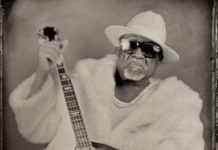Two complementary but distinct approaches to Black history in California are on display through Nov. 18 at the Healdsburg Museum. Museum Executive Director and Curator Holly Hoods has collaborated with Experiential Designer Noah Jeppson to transform the Museum exhibition gallery with vibrant color, impactful design and appropriate music to make this little-known history come alive to visitors.
“We Are Not Strangers Here: African American Histories in Rural California,” is a traveling exhibition from Exhibit Envoy, curated by Susan Anderson of the California African American Museum. Displayed on colorful banners, these untold stories challenge myths about early California and create new narratives about freedom, self-governance and civic culture.
A free cell-phone audio tour and Spanish-language text enhance the historical content.
It’s the other section of the exhibition, “Healdsburg Untold Stories,” that presents a distinctly local history. Founded in 1857 by Harmon Heald, a white farmer from Ohio, Healdsburg attracted settlers of various races, ethnicities and backgrounds. Though the new town soon boasted a population of 300, they were not all white.
From the outset, farming and merchant families displaced the indigenous Southern Pomo and Western Wappo communities. In 1860, 62% of Healdsburg farmers hailed from Southern states; 22% were from the Midwest and 16% were from the Northeast.
As curated by the Healdsburg Museum, the exhibit introduces Healdsburg’s African American founding families, including the Harper, Dennison, Hutchings, Scott, Tombs, Seawell and Robinson families. Many of their compelling life stories are being presented for the first time in this exhibition.
“It was not an easy place to live as an African American,” Hoods said. “But then, neither was the rest of California.”
Despite being admitted to the U.S. in 1850 as a supposedly “free state,” California greeted people of color with discriminatory laws from the very beginning. African American efforts to improve civil rights, justice and educational equality began immediately.
Early Black residents organized four important “Colored Conventions of California,” in 1855, 1856, 1857 and 1860. At each convention, strategies and initiatives were discussed, with the goal of improving conditions for African Americans statewide. Among the participants were William Harper and Alexander Dennison, of Healdsburg.
In 1857, 72 African-American residents lived in Sonoma County, 27 of whom were farmers. And 26 of those engaged as farmers were claimed as slaves by their employers who brought them from the South. Among them were Ellen, Taylor, Edmond, Amanda and Sarah Tombs of Healdsburg, who inhabit their own exhibit space at the museum.
“The lives of people of all races are important to understanding broad patterns of California and U.S. History,” Hoods said. “The Healdsburg Museum invites you to approach this exhibition with curiosity and empathy.”
A calendar of events is being created for fall presentations, which will include a Black History walking tour and author readings. Visit the Healdsburg Museum website, www.healdsburgmuseum.org, and follow the Museum on Facebook and Instagram.
The Healdsburg Museum, at 221 Matheson St., is open Wed to Sun, 11am to 4pm. Free admission; donations appreciated.









